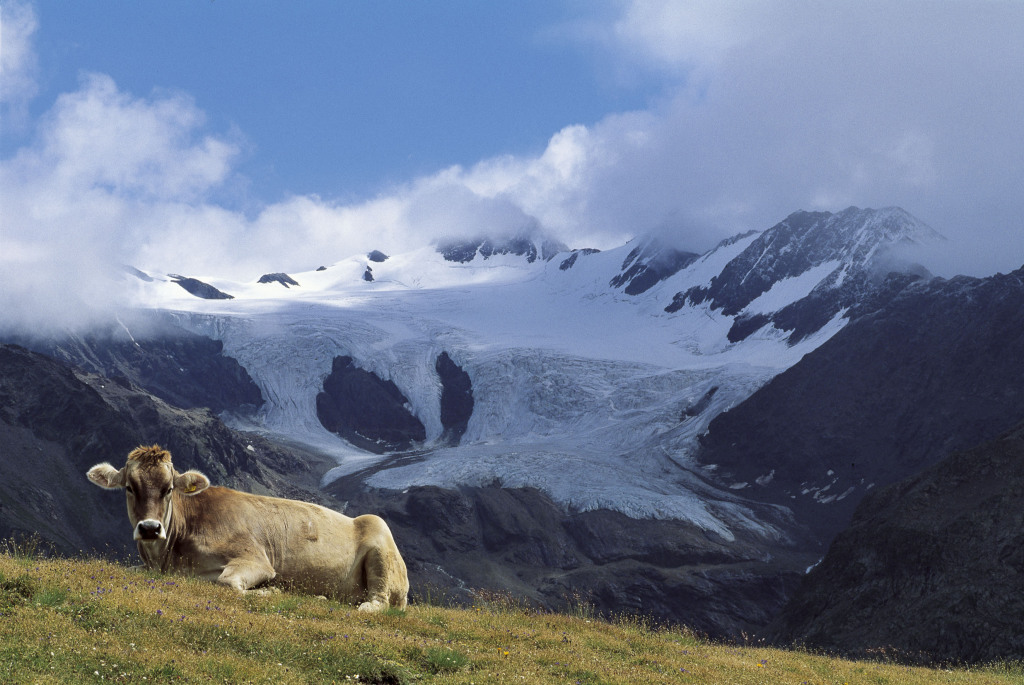 Cattle-breeding and the production of milk and cheese have very ancient origins in the province of Sondrio: the production of long-keeping cheeses allowed to transfer and preserve the nutritional properties of milk and establish production cycles which could be repeated in the same manner year after year: so, during the winter the cattle was kept in stables of the valley floor and fed with hay, while at the beginning of summer the herds began to climb towards the high pastures where they spent the summer, coming back to the valley in September, with the first cold. This form of exploitation of Alpine valleys has endured for thousands of years and endures still today, giving rise to many dairy products.
Cattle-breeding and the production of milk and cheese have very ancient origins in the province of Sondrio: the production of long-keeping cheeses allowed to transfer and preserve the nutritional properties of milk and establish production cycles which could be repeated in the same manner year after year: so, during the winter the cattle was kept in stables of the valley floor and fed with hay, while at the beginning of summer the herds began to climb towards the high pastures where they spent the summer, coming back to the valley in September, with the first cold. This form of exploitation of Alpine valleys has endured for thousands of years and endures still today, giving rise to many dairy products.
The DOP Bitto
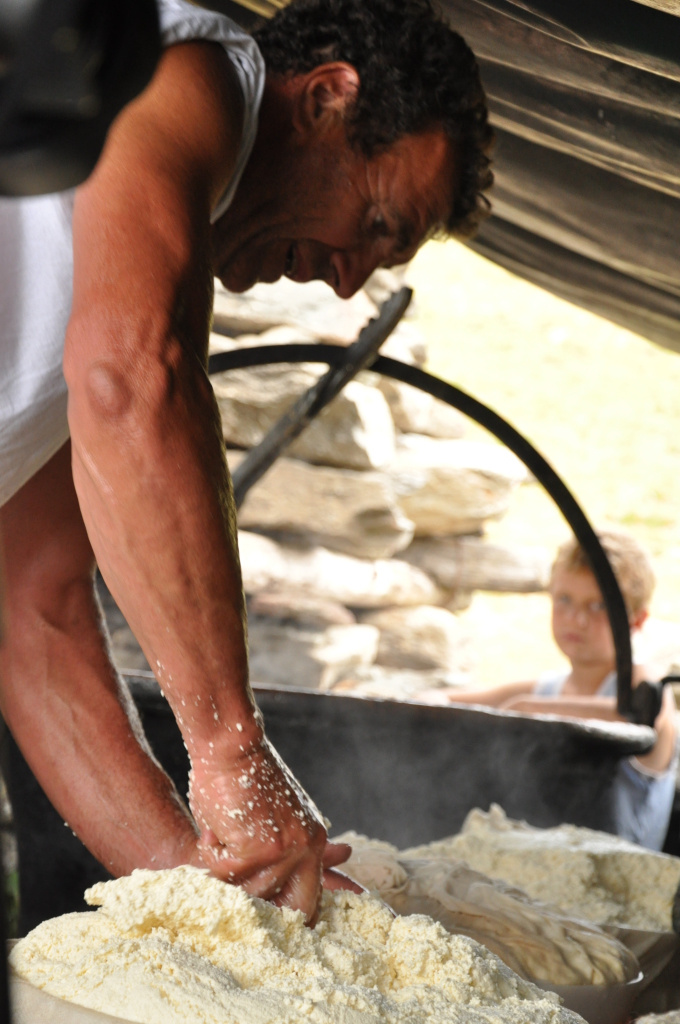 Bitto is certainly the finest and most well known cheese of Valtellina. It is produced exclusively in the alpine pastures during the summer with raw whole milk straight from the cow.
Bitto is certainly the finest and most well known cheese of Valtellina. It is produced exclusively in the alpine pastures during the summer with raw whole milk straight from the cow.
The ancient processing technique of Bitto can be traced back to the Celts who, after being driven away from the plains, found refuge in Valtellina. Celts, who were expert shepherds and dairymen, began to produce long-keeping cheeses in order to preserve and transfer the nutritional properties of milk in time and space. It is likely that the etymology of the name ‘Bitto’, which comes from ‘Bitu’ may indicate something ‘perennial’.
The land from which the milk used for processing, producing, and ripening ‘Bitto’ comes includes the pastures of the province of Sondrio as well as some neighbouring municipalities of the Alta Val Brembana (Averara, Carona, Cusio Foppolo, Mezzoldo, Piazzatorre, Santa Brigida, and Valleve) and of the province of Lecco (Introbio and Premana).
The different production stages are carried out according to the traditional uses, which are related to the environmental characteristics, between June 1st and September 30th. The feeding of the cows which produce this milk is mainly composed of grass coming from the pastures of this production area.
How to recognize it
Bitto has the uncommon property of a very long-term preservation. The best cheeses can be aged up to 10 years. Bitto is a fat cheese, characterized by cooked and semi-hard paste. Its shape is cylindrical, smooth, with flat surface whose diameter ranges between cm 30 and 50. Its sides are concave, with sharp edges, cm 8-12 high and its weight ranges between kg 8 to 25. Its paste, whose colour ranges from white to pale yellow, is characterized by a compact structure, with a few holes, following a bird’s eye pattern. The consistency of dough in young Bitto is buttery and soluble. When the cheese begins to age, and the process goes ahead, it becomes drier and allows perceiving a grainy that vanishes in the mouth.
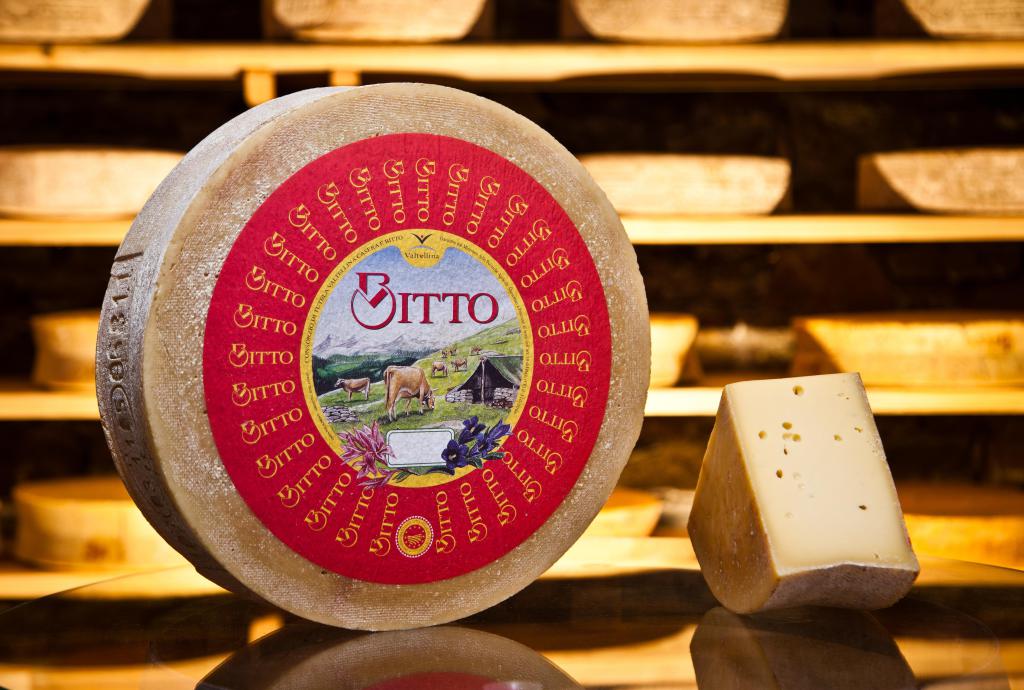 During the year in which it is produced, Bitto has a sweet and delicate flavour, which becomes more intense with the progress of ripening. The possible addition of goat's milk accentuates its characteristic aroma brought about by the grass coming from the pastures with which the cows are fed.
During the year in which it is produced, Bitto has a sweet and delicate flavour, which becomes more intense with the progress of ripening. The possible addition of goat's milk accentuates its characteristic aroma brought about by the grass coming from the pastures with which the cows are fed.
There is a dual system of marking, which constitutes a guarantee for the consumers:
- Originally Marking: it is affixed in bas-relief by the manufacturer and shows the identification number which refers to the manufacturer, the EC stamp of the pasture as well as manufacturing date (month, day, and year);
- Quality marking: it shows the writing ‘Bitto’ and is branded by the Protection Consortium only on the cheeses which follow the specifications and are at least 70 days old.
Both marks are affixed around the cheeses.
On one side of the whole cheese, a paper disc on red background is affixed.
In recent years, the yearly production of Bitto has been of about 18.000 cheeses, 2.300-2.400 quintals.
The DOP Valtellina Casera
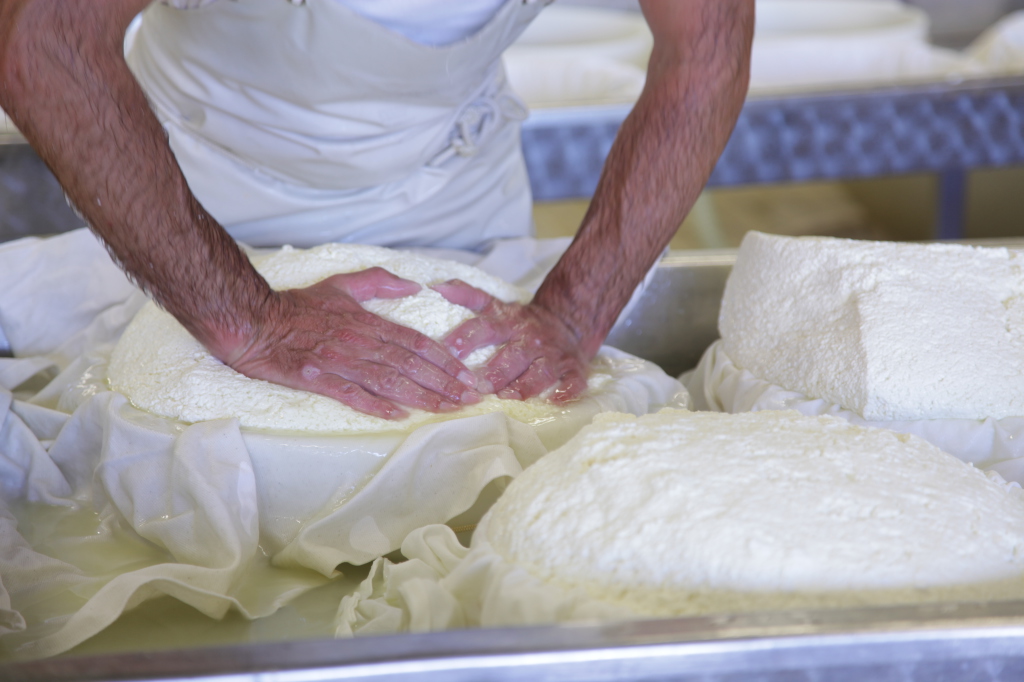 The origins of Valtellina Casera can be traced back to 1500, when more farmers joined their milk in order to carry out a collective work in the social dairies of their countries. Traditionally, the milk produced in the evening was left to rest in cool rooms and skimmed next morning. The milk obtained from the morning milking was then added, whole, to the skimmed one of the evening, and together they were transformed into Valtellina Casera. In past times, the production of Valtellina Casera was carried out only in winter, but today it concerns the whole year, thanks to the herds which are sedentary.
The origins of Valtellina Casera can be traced back to 1500, when more farmers joined their milk in order to carry out a collective work in the social dairies of their countries. Traditionally, the milk produced in the evening was left to rest in cool rooms and skimmed next morning. The milk obtained from the morning milking was then added, whole, to the skimmed one of the evening, and together they were transformed into Valtellina Casera. In past times, the production of Valtellina Casera was carried out only in winter, but today it concerns the whole year, thanks to the herds which are sedentary.Valtellina Casera is produced with cow's milk which comes from farms in the province of Sondrio only, processed in dairies located throughout this area.
The feeding of the cows which produce this milk is mainly composed of local forage.
The Consortium has identified three different ripening stages: young Valtellina Casera, from 70 day to 6 month ripening, Valtellina Casera ripened from 6 to 10 months, and Valtellina Casera ripened for more than 10 months.
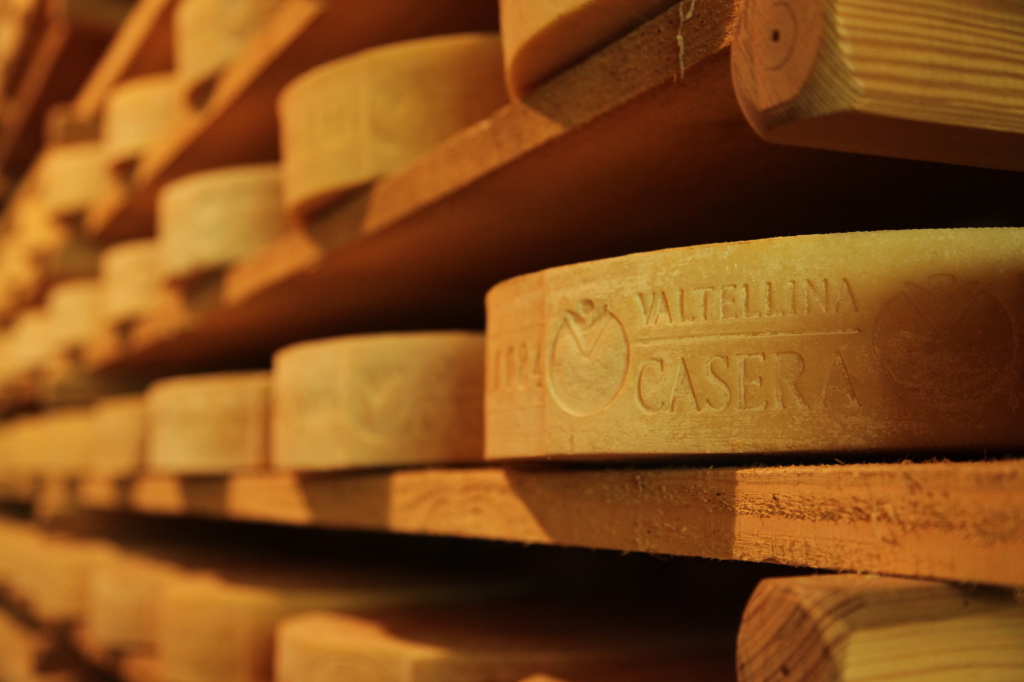 How to recognize it
How to recognize it
Valtellina Casera is a semi-fat cheese, with semi-hard and semi-cooked paste. Its shape is cylindrical, smooth, with flat surfaces whose diameter ranges between cm 30 and 45, and straight sides, cm 8-10 high. Its weight ranges between kg 7 and 12.
Its pasta, whose colour ranges from white to pale yellow depending on the time of production and ripening, is compact and elastic, with scattered holes, and basically fine. When it is ripe, its paste becomes crumbly and slightly soluble.
Young Valtellina Casera has a sweet taste, with a hint of milk. Its flavour is very delicate, easy, and very balanced. When its ripening is extended, its flavour becomes richer, with notes of dried fruits and scents of hay and forages.
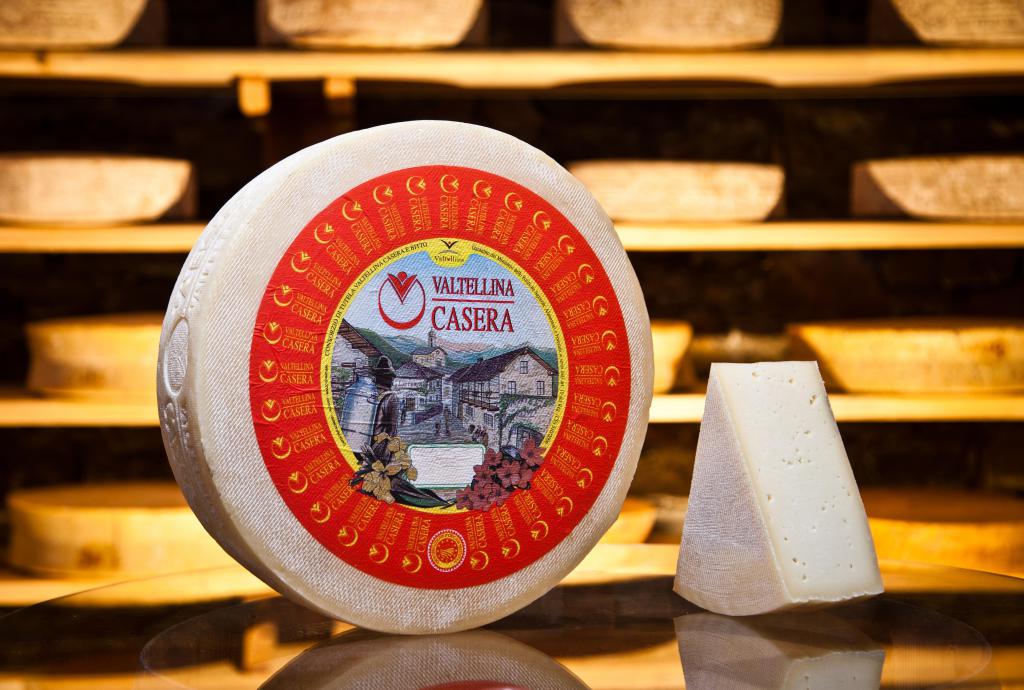 For Valtellina Casera too there’s a dual system of marking:
For Valtellina Casera too there’s a dual system of marking:
- Originally Marking: it is affixed in bas-relief by the manufacturer by means of a band which shows, besides the writing ‘Valtellina Casera’, the identification number which refers to the manufacturer, the EC stamp of the pasture as well as manufacturing date (month, day, and year);
- Quality marking: it is branded by the Protection Consortium only on the cheeses which follow the specifications and are at least 70 days old. This brand represents a stylized cheese.
Both marks are affixed around the cheeses.
On one side of the whole cheese a paper disc on red background is affixed.
In recent years, the yearly production of ‘Valtellina Casera’ has been of about 180.000 cheeses, that is about 13.500 quintals.
